教案第二章
- 格式:doc
- 大小:30.00 KB
- 文档页数:3
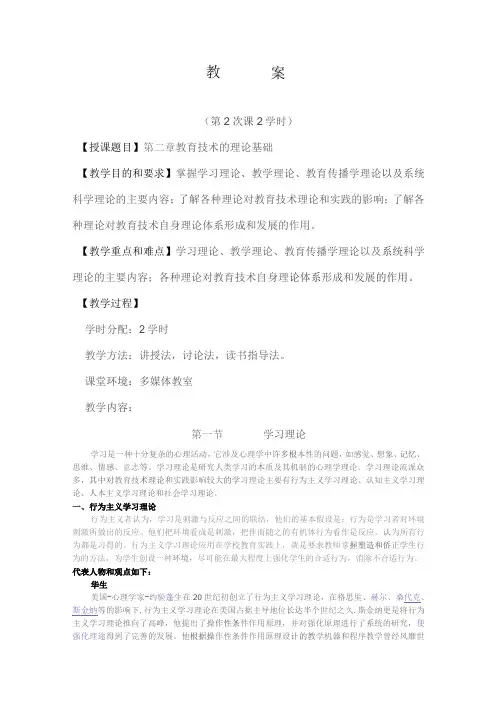
教案(第2次课2学时)【授课题目】第二章教育技术的理论基础【教学目的和要求】掌握学习理论、教学理论、教育传播学理论以及系统科学理论的主要内容;了解各种理论对教育技术理论和实践的影响;了解各种理论对教育技术自身理论体系形成和发展的作用。
【教学重点和难点】学习理论、教学理论、教育传播学理论以及系统科学理论的主要内容;各种理论对教育技术自身理论体系形成和发展的作用。
【教学过程】学时分配:2学时教学方法:讲授法,讨论法,读书指导法。
课堂环境:多媒体教室教学内容:第一节学习理论学习是一种十分复杂的心理活动,它涉及心理学中许多根本性的问题,如感觉、想象、记忆、思维、情感、意志等。
学习理论是研究人类学习的本质及其机制的心理学理论。
学习理论流派众多,其中对教育技术理论和实践影响较大的学习理论主要有行为主义学习理论、认知主义学习理论、人本主义学习理论和社会学习理论。
一、行为主义学习理论行为主义者认为,学习是刺激与反应之间的联结,他们的基本假设是:行为是学习者对环境刺激所做出的反应。
他们把环境看成是刺激,把伴而随之的有机体行为看作是反应,认为所有行为都是习得的。
行为主义学习理论应用在学校教育实践上,就是要求教师掌握塑造和侨正学生行为的方法,为学生创设一种环境,尽可能在最大程度上强化学生的合适行为,消除不合适行为。
代表人物和观点如下:华生美国-心理学家-约验蓬生在20世纪初创立了行为主义学习理论,在格思里、赫尔、桑代克、斯金纳等的影响下,行为主义学习理论在美国占据主导地位长达半个世纪之久.斯金纳更是将行为主义学习理论推向了高峰,他提出了操作性条件作用原理,并对强化原理进行了系统的研究,使强化理途得到了完善的发展。
他根据操作性条件作用原理设计的教学机器和程序教学曾经风靡世界。
华生认为人类的行为都是后天习得的,环境决定了一个人的行为模式,无论是正常的行为还是病态的行为都是经过学习而获得的,也可以通过学习而更改、增加或消除,认为查明了环境刺激与行为反应之间的规律性关系,就能根据刺激预知反应,或根据反应推断刺激,达到预测并控制动物和人的行为的目的。
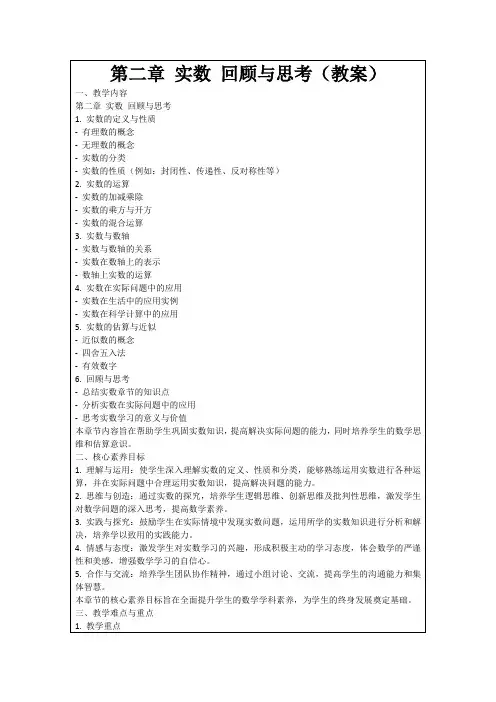
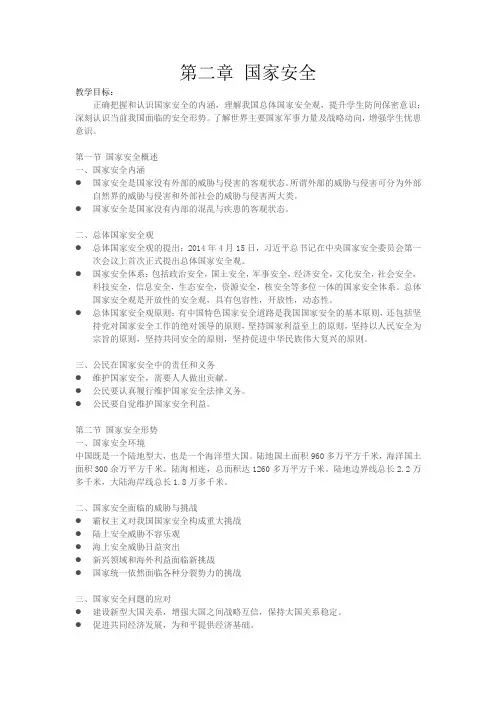
第二章国家安全教学目标:正确把握和认识国家安全的内涵,理解我国总体国家安全观,提升学生防间保密意识;深刻认识当前我国面临的安全形势。
了解世界主要国家军事力量及战略动向,增强学生忧患意识。
第一节国家安全概述一、国家安全内涵●国家安全是国家没有外部的威胁与侵害的客观状态。
所谓外部的威胁与侵害可分为外部自然界的威胁与侵害和外部社会的威胁与侵害两大类。
●国家安全是国家没有内部的混乱与疾患的客观状态。
二、总体国家安全观●总体国家安全观的提出:2014年4月15日,习近平总书记在中央国家安全委员会第一次会议上首次正式提出总体国家安全观。
●国家安全体系:包括政治安全,国土安全,军事安全,经济安全,文化安全,社会安全,科技安全,信息安全,生态安全,资源安全,核安全等多位一体的国家安全体系。
总体国家安全观是开放性的安全观,具有包容性,开放性,动态性。
●总体国家安全观原则:有中国特色国家安全道路是我国国家安全的基本原则,还包括坚持党对国家安全工作的绝对领导的原则,坚持国家利益至上的原则,坚持以人民安全为宗旨的原则,坚持共同安全的原则,坚持促进中华民族伟大复兴的原则。
三、公民在国家安全中的责任和义务●维护国家安全,需要人人做出贡献。
●公民要认真履行维护国家安全法律义务。
●公民要自觉维护国家安全利益。
第二节国家安全形势一、国家安全环境中国既是一个陆地型大,也是一个海洋型大国。
陆地国土面积960多万平方千米,海洋国土面积300余万平方千米。
陆海相连,总面积达1260多万平方千米。
陆地边界线总长2.2万多千米,大陆海岸线总长1.8万多千米。
二、国家安全面临的威胁与挑战●霸权主义对我国国家安全构成重大挑战●陆上安全威胁不容乐观●海上安全威胁日益突出●新兴领域和海外利益面临新挑战●国家统一依然面临各种分裂势力的挑战三、国家安全问题的应对●建设新型大国关系,增强大国之间战略互信,保持大国关系稳定。
●促进共同经济发展,为和平提供经济基础。
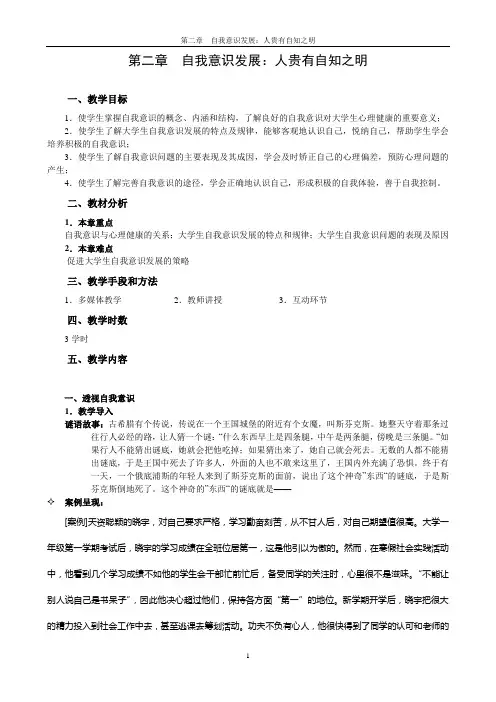
第二章自我意识发展:人贵有自知之明一、教学目标1.使学生掌握自我意识的概念、内涵和结构,了解良好的自我意识对大学生心理健康的重要意义;2.使学生了解大学生自我意识发展的特点及规律,能够客观地认识自己,悦纳自己,帮助学生学会培养积极的自我意识;3.使学生了解自我意识问题的主要表现及其成因,学会及时矫正自己的心理偏差,预防心理问题的产生;4.使学生了解完善自我意识的途径,学会正确地认识自己,形成积极的自我体验,善于自我控制。
二、教材分析1.本章重点自我意识与心理健康的关系;大学生自我意识发展的特点和规律;大学生自我意识问题的表现及原因2.本章难点促进大学生自我意识发展的策略三、教学手段和方法1.多媒体教学2.教师讲授3.互动环节四、教学时数3学时五、教学内容一、透视自我意识1.教学导入谜语故事:古希腊有个传说,传说在一个王国城堡的附近有个女魔,叫斯芬克斯。
她整天守着那条过往行人必经的路,让人猜一个谜:“什么东西早上是四条腿,中午是两条腿,傍晚是三条腿。
“如果行人不能猜出谜底,她就会把他吃掉;如果猜出来了,她自己就会死去。
无数的人都不能猜出谜底,于是王国中死去了许多人,外面的人也不敢来这里了,王国内外充满了恐惧。
终于有一天,一个俄底浦斯的年轻人来到了斯芬克斯的面前,说出了这个神奇”东西“的谜底,于是斯芬克斯倒地死了。
这个神奇的”东西“的谜底就是——案例呈现:[案例]天资聪颖的晓宇,对自己要求严格,学习勤奋刻苦,从不甘人后,对自己期望值很高。
大学一年级第一学期考试后,晓宇的学习成绩在全班位居第一,这是他引以为傲的。
然而,在寒假社会实践活动中,他看到几个学习成绩不如他的学生会干部忙前忙后,备受同学的关注时,心里很不是滋味。
“不能让别人说自己是书呆子”,因此他决心超过他们,保持各方面“第一”的地位。
新学期开学后,晓宇把很大的精力投入到社会工作中去,甚至逃课去筹划活动。
功夫不负有心人,他很快得到了同学的认可和老师的欣赏,第二学期结束时,他被选为班长,系学生会副主席。

第二章对国家出路的早期探索一、教学目的:通过本章的讲述,使学生认识到:在中国沦为半殖民地半封建社会过程中,中国的各个阶级和阶层都进行了反抗和斗争,但是无一能够取得胜利,这样就为认识到只有中国的工人阶级才能担负起领导革命的重任打下了基础。
二、重点和难点:1.评价太平天国的纲领和其失败;2.对洋务运动的指导思想和基本纲领的评价;3.百日维新述评。
三、计划课时:2课时随着资本一帝国主义的入侵,中国的民族危机和社会危机日益加深,社会各阶级都面临着“怎么办”的问题。
农民阶级、地主阶级洋务派、资产阶级维新派、资产阶级革命派,他们从各自的阶级立场出发,对国家的出路进行探索,先后提出了自己的主张和方案。
第一节农民群众斗争风暴的起落一、太平天国农民战争(一)金田起义和太平天国的建立1. 太平天国农民起义的背景(1)清政府为了支付赔款,拼命搜刮百姓鸦片战争失败以后,为支付对列强的巨额赔款,同时也为了弥补财政亏空,清政府加重了赋税的征收科派。
各级官吏在征收钱粮时往往浮收勒扣,横征暴敛,农民的负担更为加重。
正如天地会的《万大洪告示》所说:“天下贪官,甚于强盗,衙门污吏,何异虎狼”,“民之财尽矣,民之苦极矣!”(2)鸦片输入引起白银外流、银贵钱贱由于西方资本主义的入侵,中国的农业和家庭手工业相结合的自然经济逐渐解体。
鸦片贸易在战后进一步泛滥,白银外流更加严重,导致银贵钱贱,又额外增加了农民的负担。
(3)土地兼并加剧,地租剥削率日高老百姓“昔日卖米三斗,输一亩之课而有余;今日卖米六斗,输一亩之课而不足”。
田赋负担实际增加一倍以上。
这些负担归根到底,仍然落到了农民的头上。
(4)人民反抗彼伏此起残酷的压迫和剥削,迫使广大人民尤其是农民群众走上反抗斗争的道路。
1842年至1850年间,全国各族人民的反清起义在百次以上。
清政府调兵各处镇压,但群众斗争彼伏此起,酝酿着更大规模的反抗。
太平天国农民起义就是在这种情况下爆发的。
2. 太平天国农民革命的进程(1)洪秀全创立“拜上帝会”,组织群众1843年,洪秀全开始创立拜上帝会。
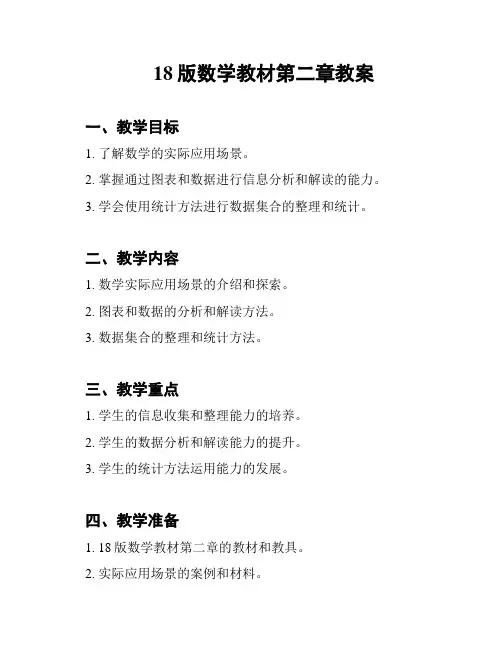
18版数学教材第二章教案一、教学目标1. 了解数学的实际应用场景。
2. 掌握通过图表和数据进行信息分析和解读的能力。
3. 学会使用统计方法进行数据集合的整理和统计。
二、教学内容1. 数学实际应用场景的介绍和探索。
2. 图表和数据的分析和解读方法。
3. 数据集合的整理和统计方法。
三、教学重点1. 学生的信息收集和整理能力的培养。
2. 学生的数据分析和解读能力的提升。
3. 学生的统计方法运用能力的发展。
四、教学准备1. 18版数学教材第二章的教材和教具。
2. 实际应用场景的案例和材料。
3. 图表和数据的分析工具和软件。
五、教学过程1. 导入:通过实际应用场景的案例引入本章的教学内容,并激发学生的兴趣。
2. 知识讲解:详细介绍图表和数据的分析和解读方法,以及数据集合的整理和统计方法。
3. 互动探究:组织学生进行小组讨论和实践活动,学生通过分析和解读图表和数据,进行信息的整理和统计。
4. 归纳总结:引导学生总结本章的研究内容和方法,加深理解和记忆。
5. 课堂作业:布置相关的练和作业,巩固学生的研究成果。
6. 反馈评价:对学生的研究情况进行评价和反馈,了解学生的研究进步和问题。
六、教学延伸1. 鼓励学生自主探索更多的实际应用场景,并进行数据分析和解读。
2. 引导学生运用统计方法进行更复杂的数据集合的整理和统计。
3. 推荐相关的数学研究资源和软件,帮助学生深入研究和应用数学知识。
七、教学评价1. 考察学生的信息分析和解读能力。
2. 考察学生的数据集合整理和统计能力。
3. 考察学生的数学实际应用能力。
八、教学反思1. 总结本课堂教学的优点和不足。
2. 分析学生的研究情况和表现。
3. 提出改进和调整教学策略的建议。
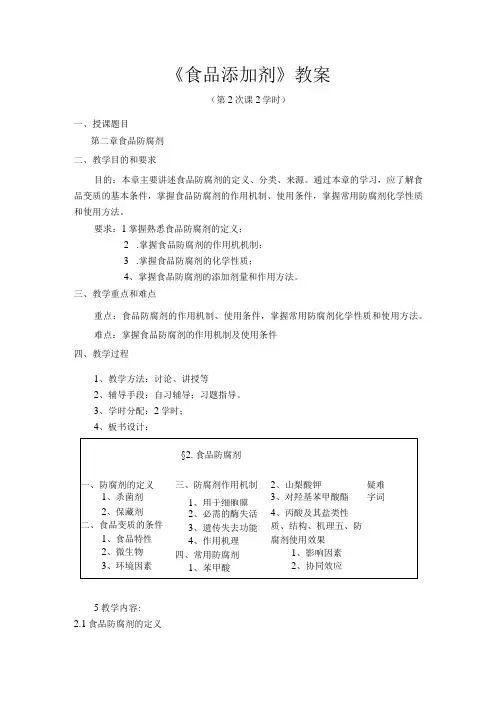
《食品添加剂》教案(第2次课2学时)一、授课题目第二章食品防腐剂二、教学目的和要求目的:本章主要讲述食品防腐剂的定义、分类、来源。
通过本章的学习,应了解食品变质的基本条件,掌握食品防腐剂的作用机制、使用条件,掌握常用防腐剂化学性质和使用方法。
要求:1掌握熟悉食品防腐剂的定义;2.掌握食品防腐剂的作用机机制;3.掌握食品防腐剂的化学性质;4、掌握食品防腐剂的添加剂量和作用方法。
三、教学重点和难点重点:食品防腐剂的作用机制、使用条件,掌握常用防腐剂化学性质和使用方法。
难点:掌握食品防腐剂的作用机制及使用条件四、教学过程1、教学方法:讨论、讲授等2、辅导手段:自习辅导;习题指导。
3、学时分配:2学时;4、板书设计:5教学内容:2.1食品防腐剂的定义防腐剂(PreSerVatiVeS)是指具有杀死微生物或抑制微生物增殖作用的物质。
如果从抗微生物的角度出发,称抗菌剂(AntimiCroba1Agents)o为了防止各种加工食品、水果和蔬菜等腐败变质,我们可以根据具体情况采用物理方法或化学方法来防腐。
化学方法即使用化学制品来抑制或杀死微生物,这种化学物质即为防腐剂。
防腐剂的概念有广义和狭义之分。
狭义的防腐剂主要指山梨酸、苯甲酸等直接加入食品中的化学物质;广义的防腐剂除包括狭义防腐剂所指的化学物质外,还通常包括认为是调味料而具有防腐作用的物质,如食盐、醋,以及那些通常不加入食品,而在食品储藏过程中使用的清毒剂和防腐剂等。
作为食品添加剂的防腐剂是指为防止食品腐败、变质,延长食品保存期,抑制食品中微生物繁殖的物质。
有的文献将防腐剂分为杀菌剂和保藏剂。
杀菌剂是指具有杀菌作用的化学物质;保藏剂是指具有抑菌作用的物质。
但杀菌剂和保藏剂没有严格的区分界限,同一物质,浓度低时能抑菌,而浓度高时则能杀菌;作用时间长可杀菌,作用时间短则只能抑菌。
同时,由于微生物种类繁多,性质各异,同一物质对一种微牛物有杀菌作用,而对另一种物质只有抑菌作用,所以笼统地将其称为防腐剂较好。
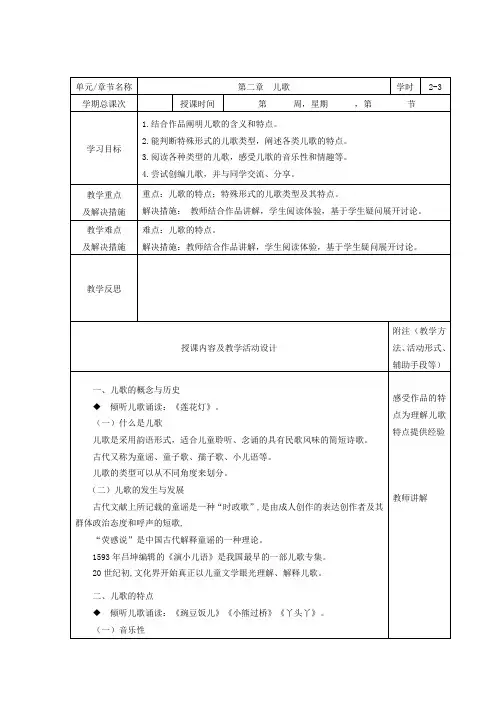

第二章物权法教学要求1.明确物权法的概念和基本原则;2.了解物权法的一般理论;3.掌握所有权、用益物权、担保物权和占有等相关法律规定。
课时安排本章节共安排7课时教学内容第一节物权法的一般理论一、物权概述(一)物权的概念与特征物权,是指民事主体在法律规定的范围内,直接支配特定的物,享受其利益,并排除他人干涉的权利。
民事财产权利中,物权为静态的财产归属关系的内容,而债权为动态的财产流转关系的内容。
物权是债权的前提和基础,也是债权的目的和结果。
与债权相比,物权具有以下特征。
1.对世性2.支配性3.排他性(二)物权的客体物权的客体,是指物权法律关系中的权利与义务所指向的对象,物权的客体为物。
物是指存在于人身之外,能够满足人们的社会需要而又能为人所实际控制或者支配的物质客体。
(三)物权的效力1.物权的排他效力2.物权的优先效力3.物权的排除妨碍效力4.物权的追及效力(四)物权的种类与保护1.物权的种类根据物权法定原则,物权的种类须由法律明文规定,不允许当事人自由创设或依其意志擅自改变。
《物权法》确定的物权类型包括所有权、用益物权、担保物权三大类,同时还设专章规定了占有。
2.物权的保护物权受到侵害的,权利人可以通过和解、调解、仲裁、诉讼等途径解决。
二、物权法概述(一)物权法的概念物权法是调整物的归属以及物的占有、利用而产生的民事关系的法律规范的总称。
(二)物权法的基本原则1.平等保护原则2.物权法定原则3.公示公信原则4.遵守社会公德原则二、物权的变动物权的变动,是指物权的设立、变更、转让和消灭。
从权利人的角度而言,物权的变动即物权的取得、变更和丧失。
我国《物权法》规定,物权变动主要有三种原因,即不动产登记,动产交付以及其他物权变动。
第二节所有权一、所有权概述(一)所有权的概念和特征1.所有权的概念所有权又称自物权,是指所有权人依法对自己的物所享有的占有、使用、收益、处分以及排斥他人干涉的权利。
2.所有权的特征(1)自权性。
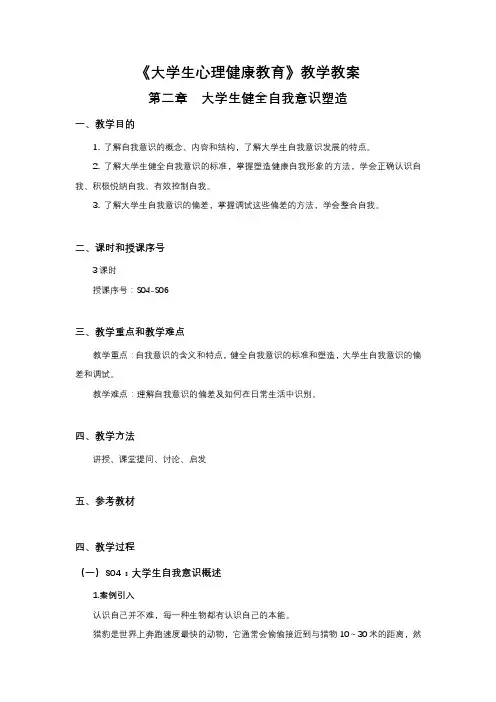
《大学生心理健康教育》教学教案第二章大学生健全自我意识塑造一、教学目的1. 了解自我意识的概念、内容和结构,了解大学生自我意识发展的特点。
2. 了解大学生健全自我意识的标准,掌握塑造健康自我形象的方法,学会正确认识自我、积极悦纳自我、有效控制自我。
3. 了解大学生自我意识的偏差,掌握调试这些偏差的方法,学会整合自我。
二、课时和授课序号3课时授课序号:S04-S06三、教学重点和教学难点教学重点:自我意识的含义和特点,健全自我意识的标准和塑造,大学生自我意识的偏差和调试。
教学难点:理解自我意识的偏差及如何在日常生活中识别。
四、教学方法讲授、课堂提问、讨论、启发五、参考教材四、教学过程(一)S04:大学生自我意识概述1.案例引入认识自己并不难,每一种生物都有认识自己的本能。
猎豹是世界上奔跑速度最快的动物,它通常会偷偷接近到与猎物10~30米的距离,然后猎捕猎物。
猎豹猎捕时的时速度最高可达到120千米/小时,且仅一脚着地。
但猎豹最多只能跑3分钟,超过此时限时生理构造使猎豹必须减速,否则它们会因身体过热而死。
奔跑3分钟后,猎豹要花更长的时间来休息。
猎豹通常在1分钟内即可猎捕到猎物,但成功的概率只有1/6。
猎豹遇到鹿群的时候,通常会飞快地奔向鹿群,鹿群则快速分散。
猎豹会选中一只鹿为目标,朝着它冲刺,而那只被追逐的鹿也以惊人的速度狂奔着。
鹿并没有跑直线,而是不断地改变奔跑的方向,迫使猎豹消耗其体力从而减慢速度。
突然,猎豹停住了,因为它没有力量再跑了。
——那只鹿逃脱了。
在野生动物的世界里,它们认识自己也认识敌人。
教师总结:每个人都有所长,也都有所短。
既然人生下来就各有不同,就要以不同的方式去充分利用自己的长处。
所谓知己知彼,百战不殆,只有充分地认识自己,才能更好地发展自己。
2.自我意识及其内涵(1)引导案例假如让你写下20个“我是……”你会写下什么?现在尝试着写一下,随便写什么都行。
下面是小美在咨询的过程中“知心姐姐”让小美写下的20个“我是……”:教师引导:让学生尝试写下20个自己的“我是…”,并分别判断属于那种自我,看学生填完后是否从中对自己有新的认识。
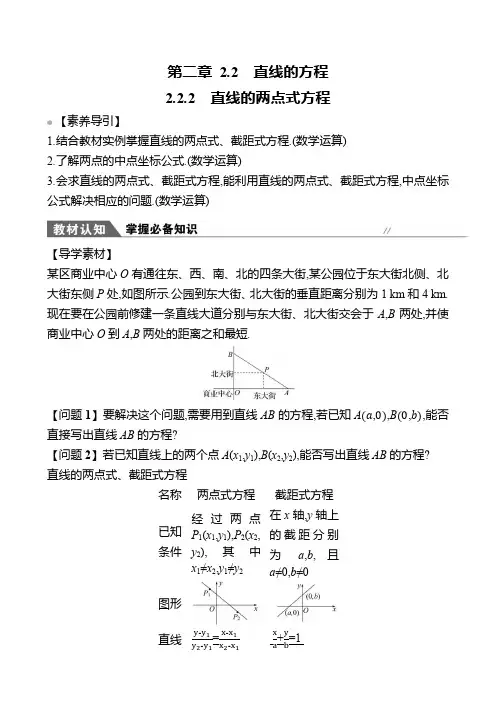
第二章2.2直线的方程2.2.2直线的两点式方程【素养导引】1.结合教材实例掌握直线的两点式、截距式方程.(数学运算)2.了解两点的中点坐标公式.(数学运算)3.会求直线的两点式、截距式方程,能利用直线的两点式、截距式方程,中点坐标公式解决相应的问题.(数学运算)【导学素材】某区商业中心O有通往东、西、南、北的四条大街,某公园位于东大街北侧、北大街东侧P处,如图所示.公园到东大街、北大街的垂直距离分别为1 km和4 km.现在要在公园前修建一条直线大道分别与东大街、北大街交会于A,B两处,并使商业中心O到A,B两处的距离之和最短.【问题1】要解决这个问题,需要用到直线AB的方程,若已知A(a,0),B(0,b),能否直接写出直线AB的方程?【问题2】若已知直线上的两个点A(x1,y1),B(x2,y2),能否写出直线AB的方程?直线的两点式、截距式方程名称两点式方程截距式方程已知条件经过两点P1(x1,y1),P2(x2,y2),其中x1≠x2,y1≠y2在x轴,y轴上的截距分别为a,b,且a≠0,b≠0图形直线y-y1y2-y1=x-x1x2-x1xa+yb=1方程适用范围 斜率存在且不为零斜率存在且不为零,不过原点【思考与交流】(1)什么样的直线的方程不能用两点式表示? 提示:与x 轴、y 轴平行的直线,x 轴,y 轴. (2)什么样的直线的方程不能用截距式表示? 提示:与x 轴、y 轴平行或重合及过原点的直线. 【解透教材】1.本质:通过直线的两点式方程可以进一步理解平面几何中“两点确定一条直线”的含义,是一种代数形式的表示.2.直线的点斜式、斜截式、两点式、截距式方程都有明确的几何意义,都涉及确定直线位置两个要素:两个点和斜率.这些直线的方程,形式不同但本质一致,都是对直线的定量刻画.在对直线的定量刻画中,斜率处于核心地位.点斜式方程是其他所有形式的方程的基础,其他所有形式的方程都是点斜式方程在一定条件下的变式. 【基础小测】1.经过两点A (-3,2),B (0,-3)的直线的方程为 ( ) A .y =13x -3 B .y =-13x -3 C .y =53x -3D .y =-53x -3【解析】选D .经过点A (-3,2),B (0,-3)的直线的方程为y+32+3=x -0-3-0,即y =-53x -3.2.(教材改编题)在x 轴和y 轴上的截距分别为-2,3的直线方程是( )A .x 3+y-2=1 B .x 2+y-3=1 C .x -2+y 3=1D .x -3+y 2=1【解析】选C .由直线的截距式方程可得x -2+y 3=1. 3.直线x 4-y 3=-1在两坐标轴上的截距之和为 .【解析】方程可化为x -4+y3=1,所以在x 轴和y 轴上的截距分别为-4和3,故-4+3=-1.答案:-14.如图,直线l的截距式方程是xa +yb=1,则a0,b0.(用>,<,=填空)【解析】由题意可得M(a,0),N(0,b),由题图知M在x轴正半轴上,N在y轴负半轴上,所以a>0,b<0.答案:><学习任务一直线的两点式方程(数学运算)1.已知直线l的两点式方程为y-0-3-0=x-(-5)3-(-5),则l的斜率为()A.-38B.38C.-32D.322.已知A(1,2),B(-1,4),C(5,2),则△ABC的边AB上的中线所在的直线方程为()A.x+5y-15=0B.x=3C.x-y+1=0D.y-3=03.过两点(-2,1)和(1,4)的直线的两点式方程为.【解析】1.选A.由两点式方程y-0-3-0=x-(-5) 3-(-5),知直线l过点(-5,0),(3,-3),所以l的斜率为0-(-3)-5-3=-38.2.选A.由题意可知.A,B的中点坐标为(0,3),又点C(5,2),所以△ABC的边AB上的中线所在的直线方程为y-22-3=x-55-0,即x+5y-15=0.3.由两点式方程可得y-14-1=x+2 1+2.答案:y-14-1=x+2 1+2【思维提升】由两点式求直线方程的步骤(1)根据题中的条件,找到或解出两个不同点的坐标.(2)由直线的两点式方程写出直线的方程.提醒:要注意判断两点是否满足两点式方程的适用条件,即两点的连线不垂直于坐标轴.学习任务二直线的截距式方程(直观想象)【典例】(1)经过点(0,-2),且在两坐标轴上的截距和为2的直线方程是 ( ) A .x 2+y-2=1 B .x -2+y2=1 C .x 4+y 2=1D .x 4-y2=1(2)若直线ax +by +6=0在x 轴、y 轴上的截距分别是-2和3,则a ,b 的值分别为( ) A .3,2 B .-3,-2 C .-3,2 D .3,-2【解析】(1)选D .依题意可设x a +y2-a=1,把(0,-2)代入方程可得a =4. 所以直线方程为x 4-y2=1.(2)选D .在x 轴,y 轴上的截距分别是-2,3的直线的方程是x -2+y3=1,化为3x -2y +6=0,所以a =3,b =-2. 【思维提升】用截距式方程解决问题的优点及注意事项(1)由截距式方程可直接确定直线与x 轴和y 轴的交点的坐标,因此用截距式画直线比较方便.(2)在解决与截距有关或直线与坐标轴围成的三角形面积、周长等问题时,经常使用截距式.(3)当直线与坐标轴平行时,有一个截距不存在;当直线通过原点时,两个截距均为零.在这两种情况下都不能用截距式,故解决问题过程中要注意分类讨论. 【即学即练】过两点(-1,1)和(3,9)的直线在x 轴上的截距为 ( ) A .-32B .-23C .25D .2【解析】选A .由两点式y -19-1=x+13+1,得直线方程为y =2x +3,令y =0,得x =-32,即直线在x轴上的截距为-32.学习任务三 与截距相关的问题(逻辑推理、直观想象)【典例】(1)过点P (2,-1)且在两坐标轴上的截距和为0的直线的方程为 .(2)经过点P (-3,2)且在x 轴上的截距等于在y 轴上的截距的2倍的直线方程为 .【解析】(1)当所求的直线经过原点时,斜率为-12,方程为y =-12x ,即x +2y =0;当所求的直线不经过原点时,设所求直线的方程为x a +y-a=1,把点(2,-1)代入可得2a +-1-a=1,解得a =3,故要求的直线方程为x -y -3=0. 答案:x -y -3=0或x +2y =0(2)根据题意,当直线经过原点时,满足,此时直线方程为2x +3y =0,当直线不经过原点,设此时直线的方程为x2a +ya =1, 直线经过点(-3,2),则有-32a +2a =1,解可得a =12,此时直线的方程为x +2y -1=0.所以要求直线的方程为x +2y -1=0或2x +3y =0. 答案:x +2y -1=0或2x +3y =0 【思维提升】当直线过原点时,利用可求直线的点斜式方程;当直线不过原点时,则设出截距式方程较为方便. 【即学即练】求经过点A (-2,2)并且和两个坐标轴围成的三角形的面积是1的直线方程.【解析】设直线方程为x a +yb=1,则{12|ab |=1,-2a+2b=1,解得{a =2,b =1,或{a =-1,b =-2.故所求的直线方程为x +2y -2=0或2x +y +2=0.。
3.课程讲解前言:(案例)中国科学院大学博士黄国平的博士论文中致谢部分反映出来的理想给人们带来的强大动力。
通过中外大家的名人名言,把理想这一主题,凸显出来。
第一节、理想信念的内涵及重要性一、什么是理想信念没有理想信念,理想信念不坚定,精神上就会“缺钙”,就会得“软骨病”。
一个人精神上“缺钙”,就容易精神空虚甚至陷入精神荒漠,既不可能感受精神生活的丰满充实,更不可能承担时代所赋予的历史重任。
1.理想的内涵与特征理想的内涵:理想是人们在实践中形成的、有实现可能性的、对未来社会和自身发展目标的向往与追求,是人们的世界观、人生观和价值观在奋斗目标上的集中体现。
2.理想的特征:首先与幻想和空想做对比幻想:违背社会发展规律、根本无法实现的想象。
如,永动机。
空想:不切合实际的、没有实现基础的想象。
如,嫦娥奔月。
然后阐述理想的特征:首先:理想具有超越性——理想因其远大而为理想。
理想之所以能够成为一种推动人们创造美好生活的巨大力量,就在于它不仅源于现实,而且超越现实。
他在现实中产生,与奋斗目标相联系,是对未来的憧憬和期待,能对现实产生巨大的推动作用。
(案例)古代两个姑娘的理想其次:理想具有实践性——理想是处在特点历史条件下的人们对社会实践活动理性认识的结晶。
离开了实践,任何理想的产生都是不可思议的。
他在实践中产生,实践中发展,实践中实现(案例)曹操的理想与实践:不同时期的曹操的不同理想和追求再次,理想具有时代性——理想同任何一种社会意识形式一样,都是一定时代的产物,都带着特定历史时代的烙印。
他受时代条件的制约,随时代的发展而发展(案例)从脱贫攻坚迈向乡村振兴饥饿的年代,理想是温饱温饱的年代,理想是文明离乱的年代,理想是安定安定的年代,理想是繁荣(案例)中国人的造桥梦。
从上海外白渡桥到杭州钱塘江大桥,中国人怀揣着造桥梦不断奋斗。
在建国后终于完成武汉长江大桥、南京长江大桥的建造。
到今天,港珠澳大桥的顺利建成,背后承载着多少中国桥梁人的倔强。
小学语文课程与教学论教案第二章语文课程教材(第三次课 2 学时)一、授课题目第二章语文课程教材二、教学目的和要求1、深刻理解语文教材的内涵与功能,了解语文教材的类型和编制原理。
2、了解小学语文教材的主要内容。
3、掌握小学语文教材分析的一般思路与方法。
4、了解现行小学语文教材的主要版本及其特点。
三、教学重点和难点教学重点:深刻理解语文教材的内涵与功能;掌握小学语文教材分析的思路。
教学难点:掌握小学语文教材分析的一般思路与方法。
四、教学过程(包含教学内容、教学方法、辅助手段、板书、学时分配等)第一节小学语文教材概述(内涵、功能、类型、编制)一、什么是语文教材?(一)教材教材是指实现课程与教学目标,承载、呈现课程与教学内容的基本材料或媒介系统。
包括:教科书、练习册、教学挂图、拼音卡片、生字卡片、教师手册、教学参考书及多媒体素材、教学软件等。
什么是语文教材?是指实现语文课程与教学目标,承载、呈现语文课程与教学内容的基本材料或媒介系统。
语文教材概念的三种理解:泛指:一切有助于培养人们的语文能力、提高人们的语文修养、对人们的语文学习产生影响的书面的和非书面的、学校的和社会的语言材料。
特指:与学校课堂语文教学直接相关的一切图书资料的总和。
专指:语文教科书,即语文课本。
(二)区分几组概念:1、“语文教材”与“语文课本”2、“语文教材”与“课文”3、“语文课程内容”和“语文教学内容”与“语文教材内容”语文课程内容——教什么是指为了达到语文科特定的课程目标而选择的事实、概念、原理、技能、态度、价值观等要素。
语文教材内容——用什么教指为了有效反映、传递课程内容诸要素而组织的文字与非文字材料及所传递的信息。
语文教学内容——学什么是指教师在教的实践中呈现的各种材料及所传递的各种信息,它既包括在教学中对现成教材内容的沿用,又包括教师对教材内容的重构——处理、加工、改编乃至增删、更换。
4、语文教材与语文课程资源5、语文教材与语文课外读物6、教教材与用教材教语文教材是为达成语文课程与教学目标、呈现语文课程与教学内容而编制的教学材料和教学媒体,它只是一种教学媒介和教学途径。
第二章基础与地下室教案一、教学目标本节课的教学目标是:1. 学生可以理解和解释建筑中基础和地下室的重要性;2. 学生能够掌握基础和地下室的设计原则和施工过程;3. 学生能够分析基础和地下室在不同建筑类型中的应用;4. 学生能够运用所学知识设计并评价基础和地下室的方案。
二、教学内容本节课的教学内容包括以下几个方面:1. 基础的种类和功能;2. 基础的设计原则和施工过程;3. 地下室的种类和功能;4. 地下室的设计原则和施工过程;5. 基础和地下室在不同建筑类型中的应用;6. 基础和地下室方案的设计和评价。
三、教学过程1. 导入介绍建筑的基础和地下室的概念,并引导学生讨论基础和地下室的作用和重要性。
2. 基础的种类和功能解释基础的不同种类,如承台基础、连续墙基础等,并说明它们的功能和适用条件。
3. 基础的设计原则和施工过程讲解基础的设计原则,如按照土壤承载力确定基础尺寸、确保基础与结构的连接等,并介绍基础的施工过程,包括土方开挖、基槽处理和混凝土浇筑等。
4. 地下室的种类和功能介绍地下室的不同种类,如停车库、仓库等,并说明它们的功能和使用条件。
5. 地下室的设计原则和施工过程讲解地下室的设计原则,如地下室的结构形式、防水处理等,并介绍地下室的施工过程,包括地下室结构的施工和防水层的施工等。
6. 基础和地下室在不同建筑类型中的应用分析基础和地下室在住宅、商业建筑等不同建筑类型中的应用特点,并进行案例分析。
7. 基础和地下室方案的设计和评价引导学生通过绘制平面图和剖面图等方式,设计和评价基础和地下室的方案。
四、教学方法本节课将采用以下教学方法:1. 演讲讲解法:通过讲解建筑的基础和地下室的概念、种类、功能等,帮助学生理解相关知识。
2. 案例分析法:通过分析实际建筑案例,引导学生理解基础和地下室在不同建筑类型中的应用特点。
3. 设计评价法:通过让学生自主设计和评价基础和地下室的方案,培养学生的设计能力和创造力。
Chapter TwoExploring Twenty-first-Century World Politics:Trend and TransformationI.The Investigative ChallengeHow can we best undrstand the political convulsions in the world that confront us almost daily? How can we anticipate their future significance? And how can we uderstand the factors and forces that most influence them? On the eve of the twenty-first century, we are being engulfed in futuist talk. We are forced to use unfamiliar language—“new century”, “new millenium”, “new world”—and to speculate, “what will the new world be like? ”Will it be different? As global conditions change, will the human vicitims and benficiaries change in the process? Or will the patterns of the past endure?How can we visualie our probable human destiny and see beyond the confines of our immediate time? For beginners, it is important to appreciate the interaction of previous ideas and events with current realities. As philosopher George Santayana Cautioned, “Those who cannot remember the past are condemned to repeat it. ”Similarly, British Prime Minister Winston Churchill advised, “The farther backward you look, the farther forward you are likely to see. ”Thus, to understand the dramatic changes in world politics today and to predict how they will shape the future, we will view them in the context of a long-term perspective that examines how the international political system—the pattems of interaction among world political actors—has changed and how some of its fundamental characteristics have resisited change. What do evolving diplomatic practices suggent about the current state of world politics? Are the duamatic changes that often have recenly sent shock waves throughout the would clearing the way for a truly new twenty-first century world order? Or will these dramatic developments ultimetely prove temporary, mere spikes on the seismograph of history?We invite you to explore these questions with us. To begin our search, we introduce three concepts that can hellp us orent our effort.Continuity, Change and Cycles in World PoliticsEvery historical period is marked to some extent by change. Now, howerver the pace of change seems more rapik and its consequences more profoud that ever. To many observers, the cascade of events on the eve of the twenty-first century implies a revolutionary restructuring of world politics. Numerous integrative trends point to that possibility. The countries of the would are duawing closer together in communications, ideas, and trade, as the integration of national economies has produced a globalization is changing the way the would works. Likewese, disintgrative trends are shaking the globe and restuctuing the way it perates, The end of stability imposed by the bipolar distubution of power bewenne the Unitied States and the Soviedt Union and their respective allies, the proliferation of conventional and unconventional weapons, global-environmental deterioration, and the resurgence of nationalism and ethnic conflict all portend a restructuring marked by disorder. The opposing forces of integration and distegration point toward a transformation in world politics as extensive and important as the system-disrupting convulsions following world Wars I and II.Distinguishing meaningful transformations(true histouical watershed), from ephemeral changes (those that gradually unfold with the passage of time but sometimes fail to last) is difficult. Transformations do not fall neatly into easily defined periods, signaling that one system has trulyended and a new one has begun. Still, major turning points in world politics usually have occurred at the end of major wars, which typically disrupt or destroy preexisting international arrangements. In the 20th cantury, World wars 1 and II stimulated fundamental breaks with the past, as each set in motion major transformations. The end of the Cold War was a histourical breakpint of no less epic significance. As US President George Bushput it in 1992, the changes stimulated by the end of the cold War were “of bibical proportions”, providing coutuies an opportunity for the first time since 1945, to rethink the premises underlying their interests, purposes, and priorities.Despite all that is radically different in world politics, much remains the same. Indeed, “history usually makes a mockery of our hopes and expectations. ”Thus leaders must “question…the ways and areas in which the future is likely to resemble the past”How can we determine when an existing pattern of relationships gives way to a new international system? Following Stanley Hoffmann(1961), we may proceed by assuming that we have a new intenational system when we have new answer to one of three questions:(1)What are the system’s basic units?(e.g., states or transnational religious movements);(2)What are the predominant foreign policy goals that these units seek with respect to oneanother? (e.g., territorisl conquest or material gain through trade); and(3)What can these units do to one another with their military and economic capabilities?These curiteria might lead us to conclude that a new system has emerge. First, new trade partnerships have been forged in Europe, North America, the Pacific Rim, and these trading blocs may behave as unitary, or independent actors as they compete with one another.Moreover, international organizations, such as the world Trade Organization and the European Union, now sometimes flex their political muscles in contests with individual states; and tuansnational religious movements ,such as Islamic fundamentalism, challlenge the global system itself (a system of state and or national actors, autonomous political units whose people perceive themsives as unified by a common language, culture, or ethnic identity.) At the same time, some states have disintegrated into smaller units. The sovied Union has fragmented into fractious political entities searching for national identity and automony. Other national units could disintegrate as well—peacefully, like the former czechoslovakia, or vilently, like the former Yugoslavia.Second, terriorial conquest is no longer the predominant goal of many states’foreign policies. Instead, theiremphasis has shited from traditional military methods of exercising influence to economic means. Meanwhile, the ideological contest between the democratic capitalism of the United States and the Marxist-Leninist communism of the Cold War-era Soviet Union no longer comprises the primary cleavage in international politics.Third, the proliferationa of weapons technology has profoundly atered the damage that states can inflict on one another. Their economic well-being, however, is sometimes dependent on those with an increasing capacity to destroy.The profoud changes in unites, goals, and capabilities of recent years have duamatically altered the ranking of states in the pecking orders that define the stucure of international politics. Still, the hierachies themselves endure. The economic hierarchy that divides the rich from the poor, the political hierarchy that separates the rulers from the ruled, the resource hierarchy that makes some suppliers and others dependents, and the military asymmetries that pit the strong against the weak all still shape the relations among states, as they have in the past. Similarly, the perpetuation of international anarchy in the absence of institutions togovern the globe, and chronic national inseccurity continue to encourage preparations for war and the use of force wighout inernational nandate. Thus change and continuity coexist, wigh both fouces simultaneously shaping contemporary world politics.The inteaction of constancy and change makes it difficult to predict whether the twenty-first century will bring a sholly new and different international system. What is calear is that this interaction will determine future relations among global actors. This, perhaps, explains why cycles so often appear to characterize world politics; Perildic sequences of events occur that resemble patterns in earlier perilds. Because the emergent international system shares many characteristics with earlier periods, histourically minded observes may experience dejavu—the illusion of having already experienced something actually being experience for th first time.The challenge, then ,is to observe unfolding global realities objectively in ordr to describe and wxplain them accurately,and hence to understand their future impact. It also reuires a set of tools for analyzing the forces of constancy and change that affect our world and that of the future. Thus ,the remaindre of this chapter will briefly examine the role that images of reality play in our undr-standing of world politics, and then will describe the theoretical orientation of the book.。